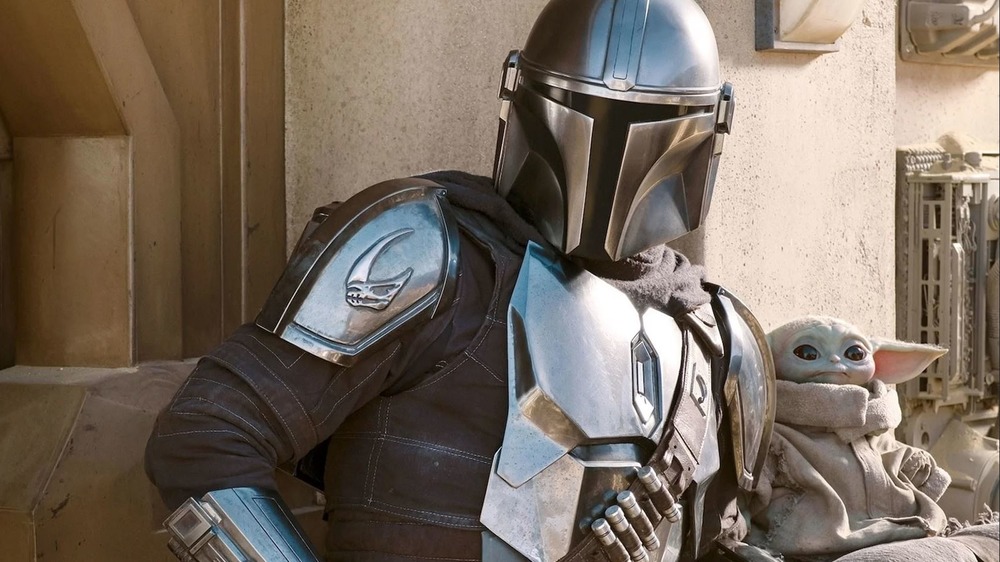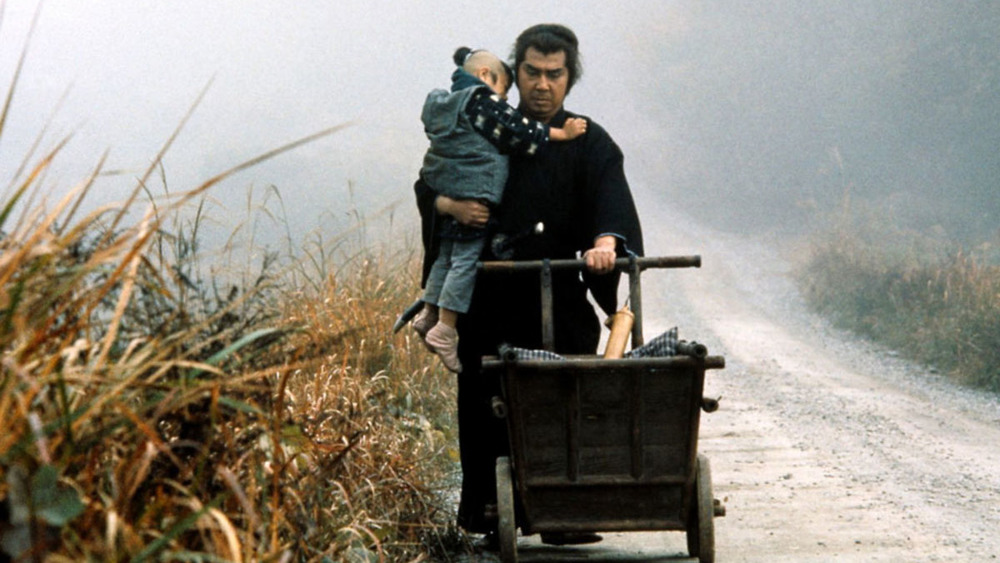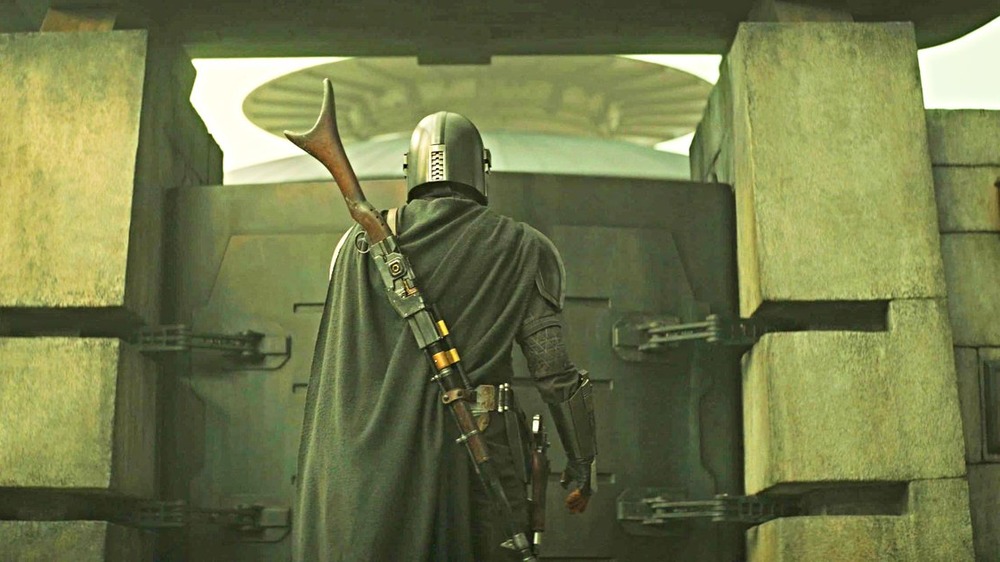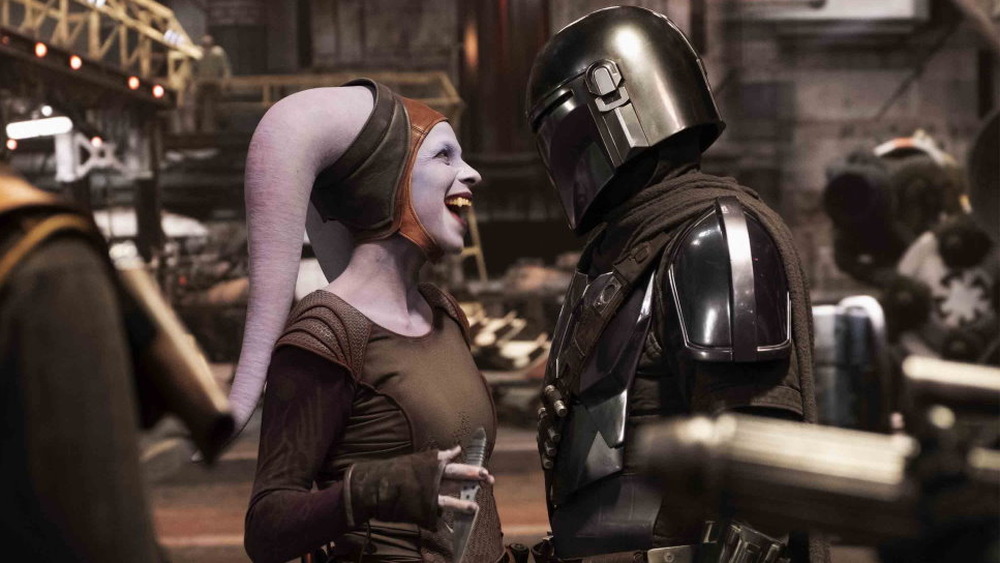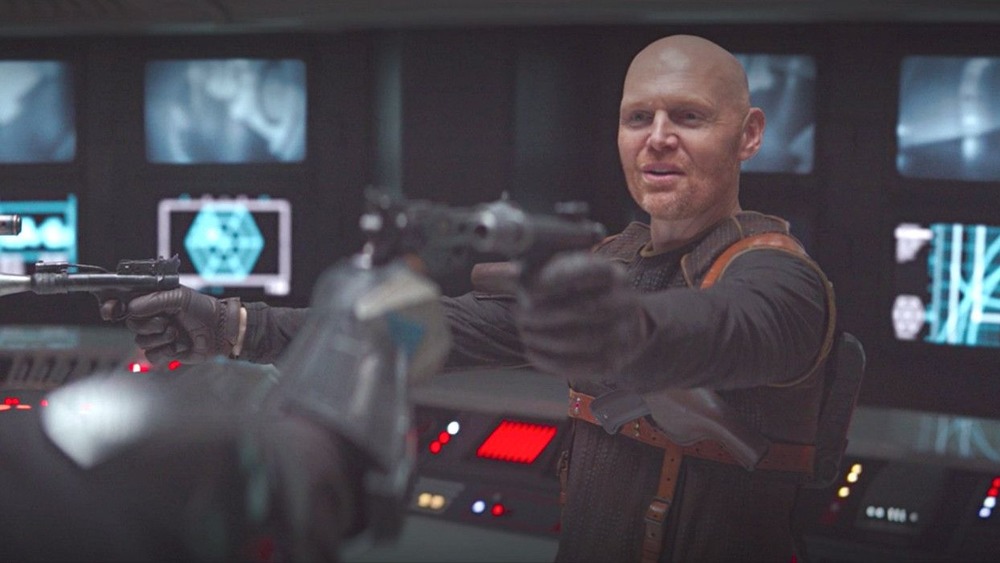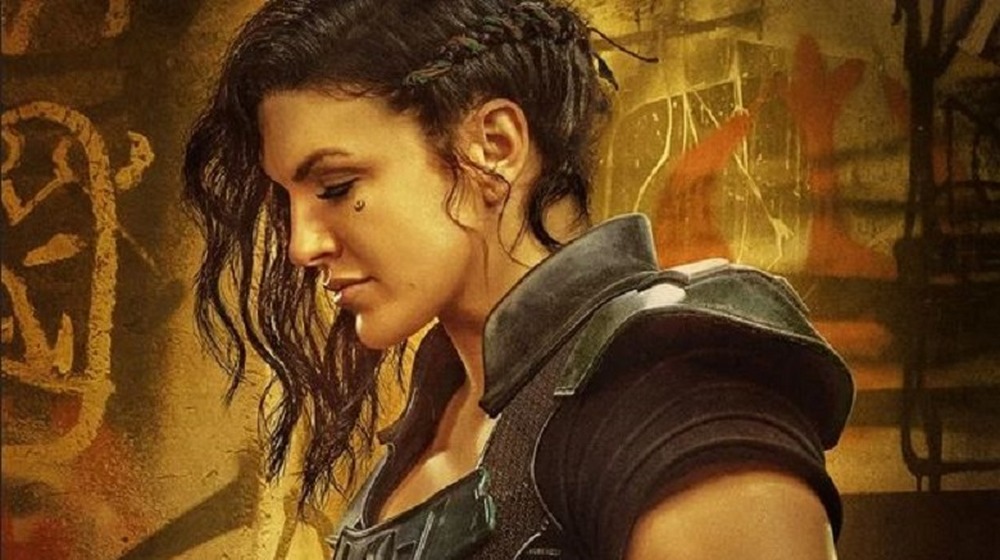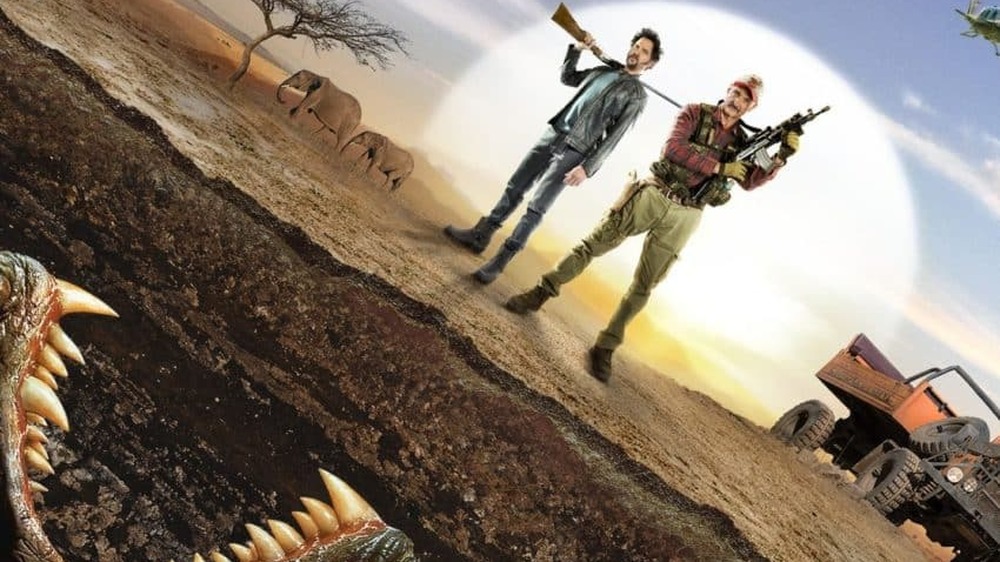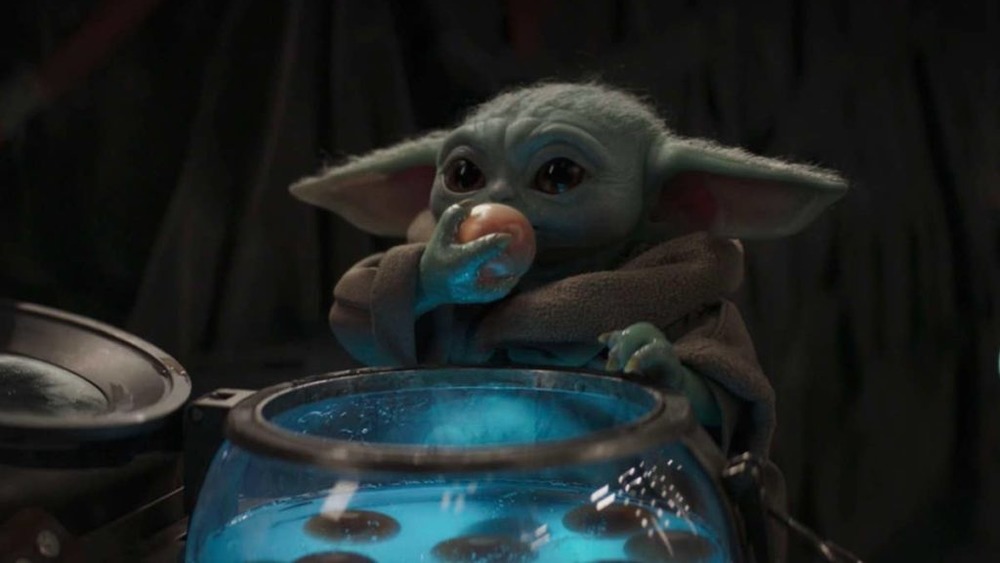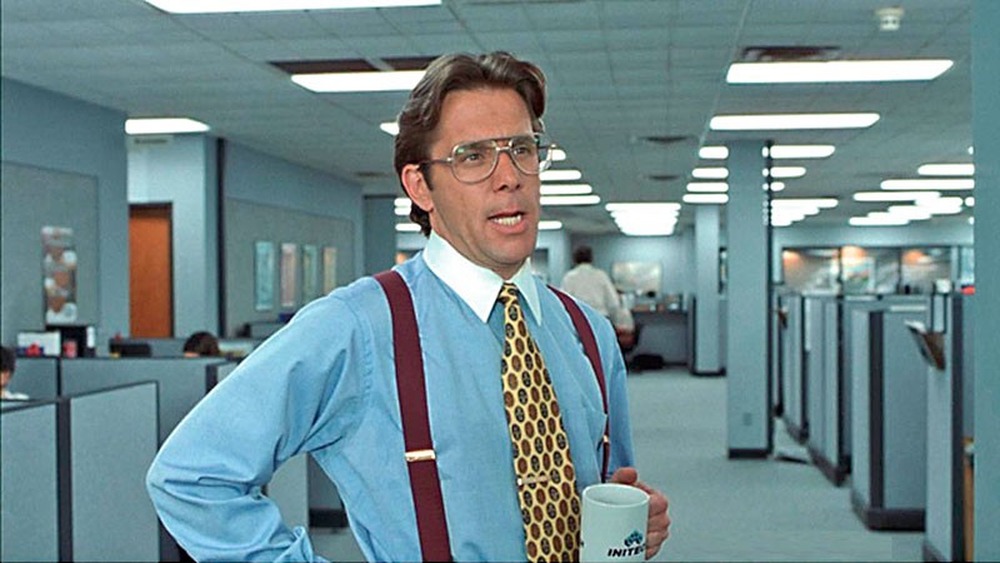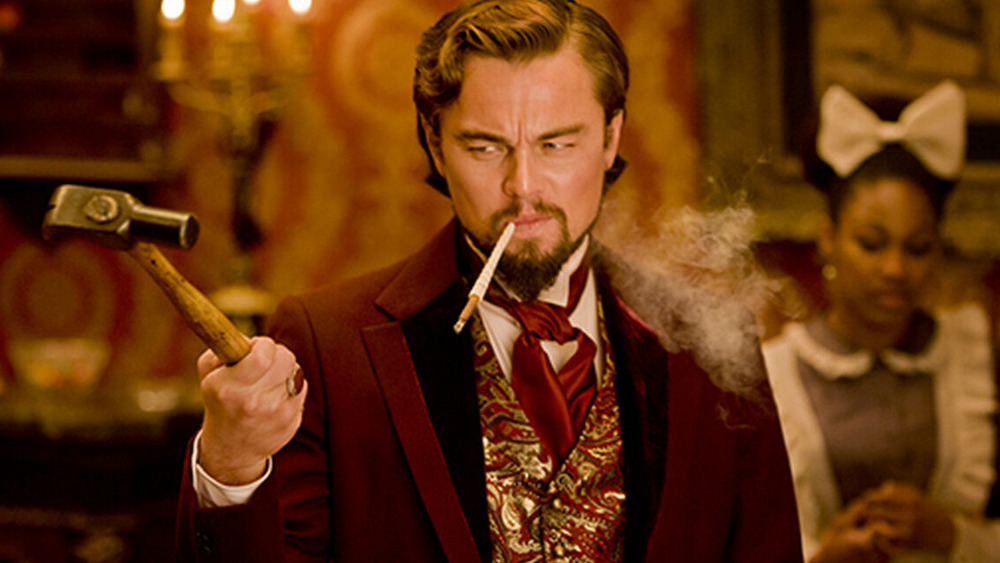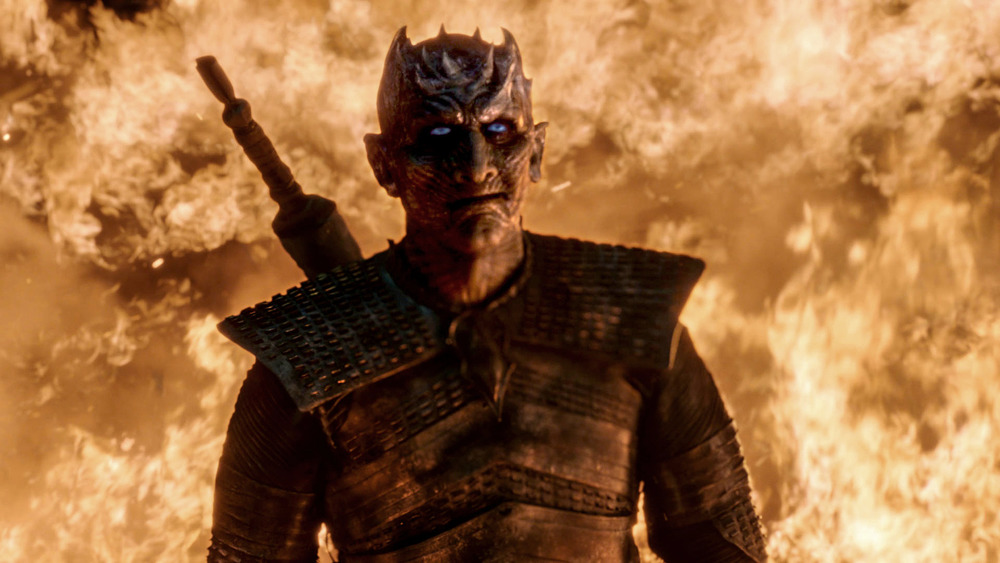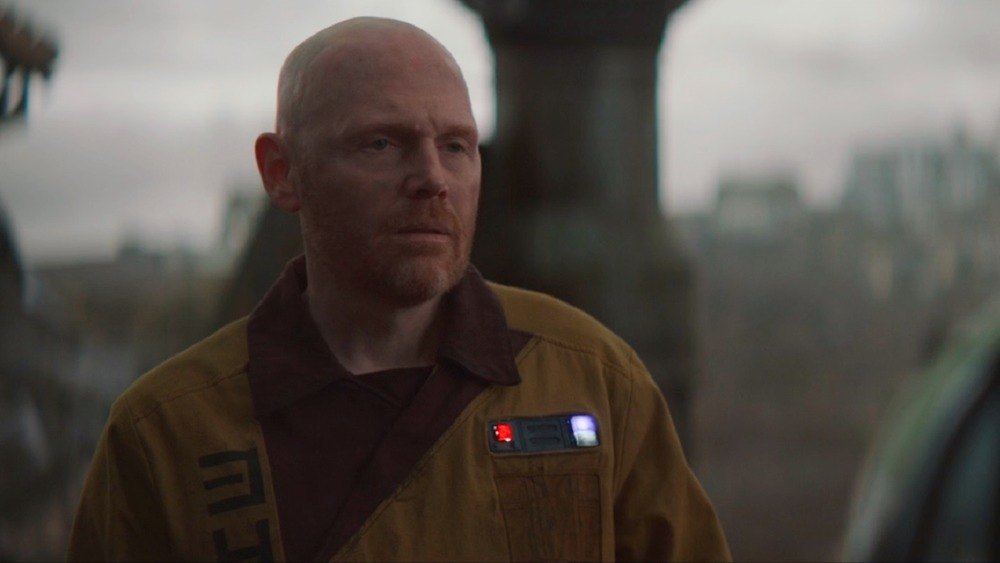Things Only Adults Notice In The Mandalorian
For two seasons, Disney's The Mandalorian has captured the hearts and minds of audiences around the world. Whether you're a diehard Star Wars fan or new to the franchise, it's nearly impossible to resist the adorable green-eared bundle that is Grogu, AKA Baby Yoda. Besides drowning in Grogu's doe eyes, viewers can't help but marvel over the puppetry and effects that went into bringing him and all the creatures of the series to life. Alongside one of the cutest beings ever conceived are some of the most badass men and women in the galaxy, all framed through the lens of gorgeous cinematography, brilliant writing, excellent casting, and cinematic music.
The show is a beautiful love letter to the original Star Wars trilogy, loaded with moments viewers of all ages can appreciate. However, The Mandalorian also has plenty of mature moments and references that are likely to go over younger viewers' heads. Homages to classic westerns and samurai films, scenes inspired by Quentin Tarantino, incorporation of Star Wars fan humor, and the shock and awe of seeing Bill Burr in a Star Wars-related project are just a few of the things only adults notice in The Mandalorian.
Space cowboys and samurai
Although it takes place in a galaxy far, far away, the Star Wars franchise can be viewed as a study of spaghetti westerns and samurai movies. George Lucas has openly acknowledged the direct influence films like Akira Kurosawa's The Hidden Fortress and Sergio Leone's The Man with no Name trilogy had on his "space cowboy" stories.
Likewise, Mandalorian creator Jon Favreau has also cited the two genres and directors as major sources of inspiration for his show — he's even been quoted as saying Din Djarin is a "deconstructed version" of Clint Eastwood's iconic Leone character. You can almost hear Mando asking some villainous scum, "Do you feel lucky, punk?" Another major Mando inspiration is Kenji Misumi's Lone Wolf & Cub, sometimes known as Shogun Assassin in the US. This classic manga follows a disgraced shogun's executioner forced onto the path of an assassin, who must take his young son with him. He pushes the little one around in a tricked-out baby cart.
On the surface, the two genres seem to share very little in common. However, both focus heavily on singular characters roaming untamed lands rife with conflict and violence. Likewise, both film genres feature characteristic cinematic elements like sweeping wide shots and emotive musical scoring. They also tend to focus on conflicts Star Wars fans are long familiar with, including the deterioration of order and the struggle to reinstate it while rebelling against corrupt empires.
The sincerest form of flattery
George Lucas pulled inspiration for A New Hope from Frank Herbert's 1965 science fiction novel, Dune — so much so, Herbert once claimed he was "trying very hard not to sue" over infringement. When examining their similarities, one can see why Herbert felt this way — the resemblances between his novel and Lucas' first film are startling.
Both star coming-of-age male heroes hailing from inhospitable desert planets on the far fringes of space, where their families eke out meager lives as water harvesters. They both also feature large vehicles known as "sandcrawlers," an illicit drug called "spice," giant slug-like creatures and sand-dwelling monsters, a force that, when mastered, allows them to control others, and a brother who shares a powerful spiritual and psychic connection with his princess sister, who both happen to be descended from the primary antagonist. The similarities go on and on, and this issue has remained a point of contention for Lucas.
The Mandalorian also seems to have pulled minor influences from Dune, as seen when Mando goes to the "city of Calodan on the forest planet of Corvus" — a reference to the novel's planets Caladan and Alpha Corvus. Whether this was an intentional nod to the novel's influence on Star Wars, the conflict that arose between Lucas and Herbert, or pure coincidence has yet to be revealed.
Maximum meta humor
Although The Mandalorian pulls heavily from the somber tones of spaghetti westerns and chanbara films, it has plenty of laugh-out-loud moments too — particularly ones poking fun at the Star Wars franchise itself. Although loaded with kid-friendly laughs, these sarcastic memes are all too familiar to mature fans, who have been dismantling all the irregularities and quirks of their beloved franchise for years.
One of the more memorable of these tongue-in-cheek scenes occurs in "Chapter 12: The Siege," while Mando, Greef Karga, Cara Dune, and the unnamed Mythrol are infiltrating an old Imperial base on Nevarro. The crew "encourages" the Mythrol to walk out on a precarious precipice over lava so as to access some machinery controls, to which he tremulously replies, "There's no guard rail on this." The stark lack of safety railings on Empire ships is something Star Wars fans have been joking about since the first film was released in 1977, and was most notably mocked in the Star Wars parody episode of Family Guy, "Blue Harvest."
Another hilarious moment of self-deprecation in The Mandalorian happens during the cold open of "Chapter 8: Redemption," which shows two stormtroopers missing repeatedly while firing at a piece of scrap within close range, playing on the age-old trope of their notoriously poor blaster aim. Some theorize shoddy weapons are to blame, which would be a convenient excuse.
Din is quite the ladies' man
For a guy who never shows his face, Din Djarin is a huge chick magnet. Younger viewers may not notice, but mature audiences will pick up on the fact that, excluding Cara Dune, the few non-Mandalorian females he's crossed paths with have either been instantly attracted to him, or had some sort of romantic history with him. What can we say — some women love a man in uniform while others like bad boys, and Mando fits both those types.
In "Chapter 4: The Sanctuary," Din crosses paths with a young widow named Omera, with whom he could have lived a tranquil life sipping spotchka, if not for that blasted Mandalorian Creed. Bad boy Mando also seems to have broken the heart of Xi'an, a knife-throwing Twi'lek he works with in "Chapter 6: The Prisoner." She threatens to use her blades against him for whatever shenanigans he pulled on her in the past. For all her wrath, Xi'an refuses to disclose if Din truly wears his helmet "all the time." As she teases, "A lady never tells."
Bill Burr ... in space!
A truly weird thing adults notice in The Mandalorian is the sheer irony of seeing comedian Bill Burr cast in a Star Wars-related role. Longtime fans of his podcast know that the snarky Bostonian has long riffed on the franchise, as he never forged a personal connection with the original trilogy when it was released in his youth.
Burr stirred up controversy within the Star Wars universe for remarks he made in 2015, declaring that when he did finally watch the original trilogy in his mid-20s, it felt like a "cheesy self-help book put in outer space with, like, Muppets." To be fair, "Ole Billy Red Face" makes fun of everyone and everything equally, even his beloved sports teams. Still, it may seem curious that Jon Favreau would cast a devout Star Wars hater in The Mandalorian. But in an ironic twist of fate, Burr claims Favreau chose him precisely for this reason, stating he thought it would be "funny" — and it most certainly is, Mr. Favreau!
From MMA to a galaxy far, far away
Little girls everywhere have found a true hero in Gina Carano's tough-as-nails Cara Dune, but adult fans recognize her for more than just her killer role on The Mandalorian. Carano's background makes her the ideal candidate for playing Cara Dune, the most recent addition to Star Wars' collection of fierce brunette heroines. Before she started acting, Carano was a Muay Thai fighter who launched her career as one of the first mainstream female mixed martial artists, competing back when the sport started blowing up in the 2000's.
After earning an MMA record of seven wins, one loss, and zero draws, Carano transitioned into acting in 2008 with the role of Natasha Volkova in EA's acclaimed real-time strategy video game, Command & Conquer: Red Alert 3. Her ability to perform her own stunts and make action look realistic on-screen has kept her busy with various action roles since — most notably as Mallory Kane in Haywire, Riley in Fast & Furious 6, and Angel in Deadpool.
That's how they get you
Yet another influence bound to be missed by younger viewers can be seen in "Chapter 9: The Marshall," in which Mando travels to the frontier town of Mos Pelgo on Tatooine seeking out other Mandalorians to aid him on his quest. (In a fun twist, Deadwood's Timothy Olyphant and W. Earl Brown play the Marshall and the Weequay bartender, further adding to the western elements of the show.) Mando gets sidetracked helping the Marshall destroy a local sand-dwelling monster that has been plaguing his town, known as a greater krayt dragon.
Krayt dragons are initially mentioned in Star Wars: A New Hope, when Obi-Wan Kenobi scares off a group of sand-people attacking Luke Skywalker by imitating its eerie howl. A krayt dragon's bleached skeleton can also be glimpsed poking out of the Tatooine sand behind C-3PO early in the film. This terrifying beast shares many similarities with the sand-bound creatures haunting the pages of Dune, but it also hearkens back to the 1990 sci-fi horror cult classic, Tremors. In that movie, giant worm-like creatures called "graboids" lurk underground, waiting to strike their next human victim when they least expect it.
The birds and the bees
Baby Grogu may be one of the greatest things to come out of the Star Wars franchise. His adorable visage helped many fans get through the colossal challenges of 2020 — you just can't help but take refuge in his calming presence and big dark eyes. While innocent young minds go no further than admiring Grogu's cool powers and cuteness factor, adult minds can't help but wonder where Grogu came from.
If he's not a clone, as has been implied in the show thus far, then he either was spontaneously created like Anakin Skywalker, or he was "made" the old fashioned way — and you can bet that way wasn't a dactyl stork dropping him off on the Jedi temple's doorstep. So far, the only other creatures encountered like Grogu in Star Wars have been Yoda and Yaddle. Could Grogu's existence explain the latter's sudden disappearance from the Jedi High Council?
That all remains fan theory for now, but regardless of who sired the little womp rat formerly known as Baby Yoda, the twisted adult mind can't help but wonder how such creatures would accomplish procreation. Awkward it would be, yes? A pleasant image, it is not.
Bill Lumbergh has infiltrated the Empire
Unless you know some kids with very strange and mature taste, they likely miss a quick Mandalorian reference to one of the greatest films of all time: Office Space. A comedic and philosophical examination of the rat race, starring Jennifer Aniston and Ron Livingston, Office Space parodies all the negative aspects of toiling away at the dreaded nine-to-five cube farm.
From horrible bosses and wasting away in traffic, to lame office birthday parties and awkward water cooler talk, to not "wearing enough flair," anyone who has ever worked a less-than-desirable job can relate to this movie. Office Space also makes fun of unnecessary corporate bureaucracy and paperwork, symbolized by the dreaded "TPS reports" in the film.
These reports seem to have made their way into the Star Wars universe, because Mayfeld mentions them in "Chapter 15: The Believer." It's such a quick line, and easy to miss: "Let's go fill out those TPS reports, so we can go recharge the power coils," Mayfeld says to Mando while posing as Empire transport personnel. And you thought the Empire was evil before...
Traces of Tarantino
Chapter 15 is loaded with Quentin Tarantino references which hopefully no child in the audience takes note of, as they're way too young to watch any of his movies. Mayfeld and Mando find themselves in a dangerous situation while posing as Empire personnel, when officer Valin Hess insists they join him for a drink. They risk exposing themselves while swapping small talk, but they can't break rank by refusing Hess' offer, so they acquiesce.
The suspenseful scene is reminiscent of the hair-raisingly intense "bar scene" in Inglourious Basterds: Both feature characters infiltrating enemy cultures while attempting to blend in as natives, and both situations instantly explode into a violent catastrophe with very little chance of escaping alive. Mando and Mayfeld's frolic at the Empire bar also reminds the adult viewer of another Tarantino scene from Django Unchained, when Dr. Schultz gives Calvin Candie a bullet rather than a requested handshake.
Leonardo DiCaprio does such a stellar job portraying the dastardly Candie, his on-screen death has to be one of the most satisfying of all Tarantino's many executions. Just like Schultz, Mayfeld is so overcome with loathing he can't help but pull the trigger, and thus puts his companion in grave danger. Also like Candie, Hess has a thick Southern accent, and a sinister yet lackadaisical demeanor.
Winter is coming
A towering villain requires an actor of serious skill. Luckily, The Mandalorian's Valin Hess is played by a highly accomplished actor adults will likely recognize: Richard Brake. Brake succeeds in making his character absolutely hateful, but then, as grown-ups know, he has a lot of experience in that department.
Brake started his acting career in 1993, with a small part as a reporter in a British comedy-drama TV series, Jeeves and Wooster. Since that time, Brake has performed in dozens of projects and at least 30 films spanning all genres. He was the murderous thief Joe Chill in Batman Begins, Bob the tattoo artist in Perfect Skin, and served in the Asgardian army as an unnamed "Einherjar Lieutenant" in Thor: The Dark World. One of his more memorable roles to date has also been one of his most brief — he was cast as the Night King in the fourth and fifth seasons of Game of Thrones.
Operation Cinder
Mayfeld doesn't shoot Officer Hess for a frivolous reason, or, as younger viewers may assume, simply because he's a bad guy. More mature and experienced viewers will recognize Mayfeld's PTSD getting the best of him — and once you learn his tragic backstory, the depth of his trauma is revealed.
Mayfeld was a survivor of Operation Cinder, an insidious contingency plan set in place by Emperor Palpatine in case the Empire failed to prevent his death. According to Palpatine's twisted world view, if the Empire couldn't protect him, it didn't deserve to exist, so he sought revenge posthumously by destroying designated planets with drone-delivered fire and brimstone. Burnin Konn was one of those unlucky planets, and Mayfeld was on it the day Operation Cinder went into effect.
It sounds like an absolute nightmare beyond imagining, and you can see the intense emotion sweeping across Mayfeld's face as traumatic memories of the incident come flooding back, while Hess obliviously prattles on. Bill Burr's acting is excellent in this scene — the man can seriously emote, even in a franchise he's ruthlessly made fun of in the past.
